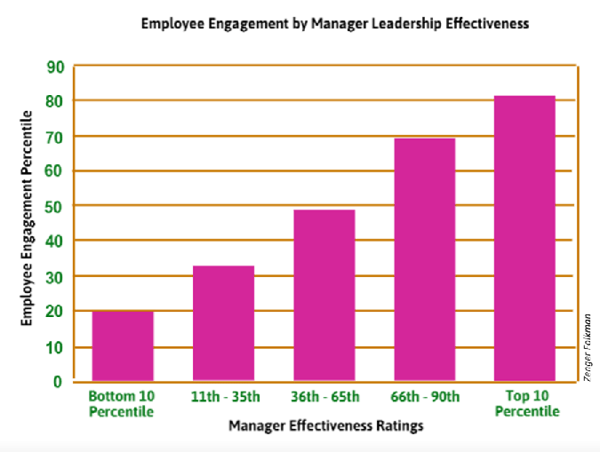Why Is Employee Engagement Important?
As noted in last week’s article, the business benefits of employee engagement are extensive and include:
- Higher rates of retention for your top-performing and high-potential employees
- Increased productivity (output, quality, efficiency, etc.)
- Stronger customer satisfaction and loyalty
- Improved top-line revenue
- Higher profitability
Employee engagement is the emotional connection a person feels toward the organization. That emotional connection causes the employee to apply additional discretionary effort to their work.
Because engagement hinges on an emotional connection, we have to consider employee’s emotions in the workplace. Happiness at work is a good place to start.
Are Your Employees Happy at Work?
The data tells us that there’s work to be done when it comes to workplace happiness.
- Only 44% of employees are happy in their current role (Hays)
- 25% of workers described their workplace as “happy” (Spherion)
Less than half of employees are happy in the workplace.
Maybe yours are an exception. But if you’ve never thought about this, asked employees about this, or considered this as a strategic initiative for driving business results, it’s more likely that your employees are less happy than you’d like to believe.
What Are the Benefits of Happy Employees?
Happy employees are more likely to be engaged employees. Hence, the benefits linked to employee engagement carry over here. Suffice it to say that “engagement is the primary enabler of successful execution of any business strategy” (DDI – Employee Engagement: The Key to Realizing Competitive Advantage).
Let’s look, then, at the impact of having unhappy employees. As you read these findings, consider the alternatives that go hand-in-hand with shifting in ways that improve employee happiness.
- 58% of working Americans claim that their coworkers are more productive at work when they're happy (Ultimate Software)
- 85% of employees said they felt overwhelmed, extremely down, or are experiencing negative feelings that interfered with their ability to work (TAO Connect)
- Declining employee loyalty is thought to harm organizations by causing low morale (84%), high turnover (80%), disengagement (80%), growing distrust (76%), and lack of team spirit (73%). (American Management Association)
- New hires who reported a poor onboarding experience are 8x more likely to be disengaged in their work and 11x less likely to recommend their employer as a good place to work after their first three months (Glint)
This is just a sampling of the volumes of data available about employee sentiment and mood in the workplace.
The ultimate benefit of having happier employees is that business thrives. Intentional focus on providing a positive employee experience is no less important than providing a positive customer experience.
Next Steps for Improving the Employee Experience
Note the common denominator in these two findings about a positive employee experience.
- 79% of employees with flexibility indicated that they were happier at work than those with less flexibility (IBM)
- Feedback, recognition and growth are contributors to a positive employee experience. (Globoforce)
Both contributors to happiness rely, ultimately, on the manager. The person most responsible for how employees feel about their work is their manager.
Senior managers need to set the tone. They need to allow for flexibility and model appropriate engagement activities like recognizing employees for their contributions.
Senior managers must also hold managers accountable for more than functional work output. It’s short-term thinking to look only at short-term business output. Building the business for the long-term depends on an organization’s ability to sustain growth rates, satisfy customers, manage expenses wisely, and deliver high quality efficiently. None of this is possible when turnover rates are high and employee morale is low.
HR recruiters can only “plug the dam” for so long. If people are leaving, look at the managers they report to and what they need to do differently in order to improve employee engagement. Look, too, at the policies, practices, and examples those managers are provided.
As this graph indicates, the leadership of a manager matters greatly. That’s because it’s leadership behaviors (not task management!) that impacts how people feel about their work.

Don’t leave your managers alone to fend for themselves and figure this out. Equip them with the know how they need to become more effective at boost employee engagement.
Want more information about PFPS training and consulting for managerial effectiveness and happy employees?

